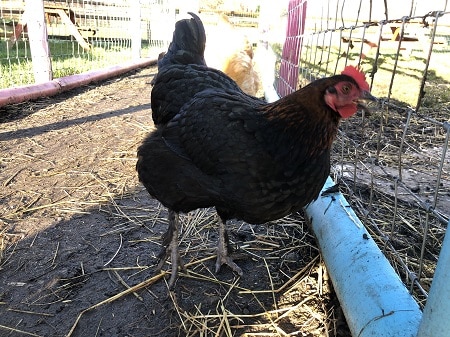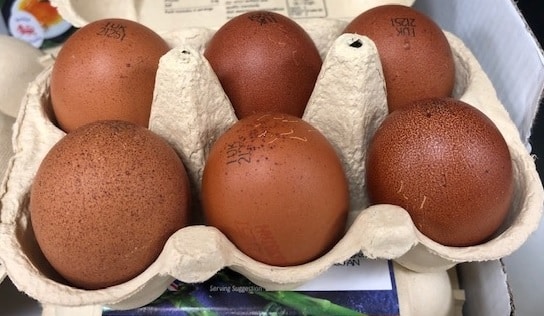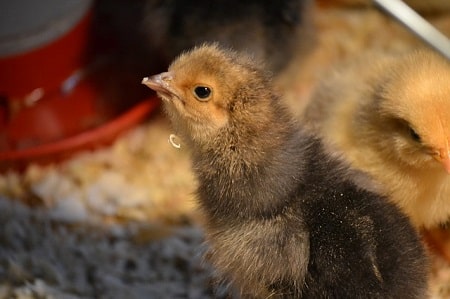There isn’t much if any difference between eggs based on the color of their shells. However, I’m not alone when I say that a Marans’ dark brown chestnut-colored eggs look like they would taste better.
Marans eggs are one of the richest, darkest, chocolate-colored eggs chickens lay. There are some interesting facts behind the history of this magnificent bird too, as I will explain in this article.
Table of Contents
History of the Marans Chicken Breed
The Marans chicken gets its name from the town in France where it was first developed all the way back in the mid-1800s, Marans.
It was introduced to the UK in the 1930s and only found its ways onto U.S. shores in the 2000s. It was when hobbyists realized that they laid dark eggs that their popularity exploded.
There was once a demand for their eggs that could not be met, as happens with many new and exciting discoveries.
This led to Marans eggs being called “the most expensive chicken eggs in the world” when people couldn’t get their hands on them. This wasn’t true though, of course.
Marans are classified as a dual-purpose breed because they are bred for both their beautifully rich chocolate brown colored eggs and their meat.
There Are 9 Colors/Varieties of Marans

There are 9 recognized colors of Marans in the French standard. These are:
- Black Copper
- Black
- Cuckoo
- Golden Cuckoo
- Wheaten
- Black-tailed Buff
- White
- Colombian
- Birchen
In April of 2011, the Marans Chicken Club USA was able to get the first of the 9 colors recognized by the American Poultry Association - the Black Copper Marans. Other colors have also since been added by the APA, namely the White and Wheaten Marans.
How Many Eggs Do Marans Lay a Year?
Depending on the variety, Marans hens typically lay around 150-200 eggs a year.
What Color Eggs Do Marans Lay?
I’ve been talking about this a lot as it’s the main feature of the Marans and one of the most desirable egg colors in the egging community.
Marans are “chocolate eggers”.
Much like the descriptive term “olive eggers” it means exactly what it says. They lay chocolate colored eggs.
Of the 9 recognized varieties, the Black Copper lays the darkest color eggs. With the Silver Cuckoo following closely behind. All 9 lay eggs ranging from a milk chocolate color to a rich dark chestnut.
Breeders talk openly about finding it difficult to improve the egg color through generations consistently, however.
Hens will lay different shades of eggs throughout the year, despite maintaining the same diet and environmental factors. Their eggs are also known to be darker when temperatures are lower in the winter months, and vice versa in the summer.
Facts About Marans Eggs

I’m going to reveal how and why Marans eggs are a gorgeous chocolate color (it’s not what you think), if they really do taste better, and more - all in these facts:
- Marans eggs taste the same as any other hen’s egg. That is if they have comparable nutrition and living conditions to other hens laying different color eggs.
- The egg color can actually be wiped off to reveal a “normal” colored egg! That’s right, it’s not a spray paint job to add value to the egg, it's a wet mucous coating during laying.
- Their eggs tend to be darker in the winter months when it’s colder, and lighter in the warmer summer months.
- Sometimes their eggs are speckled too!
- The Black Copper Marans is the variety that lays the darkest eggs. If you’re buying some hens just for the eggs, always go for a Black Copper.
- They tend to start laying later than other breeds, 6 months is normal while 8-9 months is not unheard of.
- Once they are into a full laying schedule you can expect around 3 eggs per week.
Is a Marans the Right Chicken for You?
If you’re thinking about adding to your backyard flock or want to start keeping Marans to enjoy some of their dark eggs, here is everything you need to know about this breed:
First of all, they are one of the more friendly, calm, and social breeds. This makes them the perfect choice for owners that like to handle and communicate with their flock.
They are very good at foraging, too, and thrive as free-range chickens. The only thing to be aware of is that they are prone to getting overweight, which is a bonus if they’re going to end up on the table of course.
Hens are broody and good mothers, the roosters are not known to be aggressive. It all sounds a bit too perfect, doesn’t it!?
Getting Started

As always when starting with backyard chicks, you have a few options; hatching eggs, day-old chicks, started chicks, and adults.
Here are the pros and cons of each stage of development:
Hatching Eggs
Hatching eggs is the least expensive and most fun (in my opinion) way to get started with chicks. For me, there’s nothing quite like being witness to baby chicks hatching from an egg.
Looking on Cackle Hatchery it’ll set you back about $84 for a dozen Black Copper fertilized hatching eggs.
Day-Old Chicks
Day-old chicks are always a safe bet if you’ve not experienced hatching eggs yourself. There is a much lower chance of losing some, and it doesn’t cost much more.
The downside is that like picking up a clutch of straight-run chicks there are no guarantees how many females and males you’ll have.
Started Chicks
If you’re buying started chicks you are going to pay more, but you can be more picky about the colors, age, and sex of the chicks.
The problem with Marans, however, is that they molt three sets of feathers before maturing. If you’re looking for a show bird, it’s hard to know what they will turn out like.
Mature Hens / Roosters
If you can find adult hens, you can be sure you’re going to get those dark eggs you’re after a lot sooner.
Marans are one of the later breeds to start laying, most owners see their first eggs at 6 months, with some waiting until 8-9 months.
If you have space you can buy a rooster and hens and breed your own chicks. Enjoy the best of both worlds.




